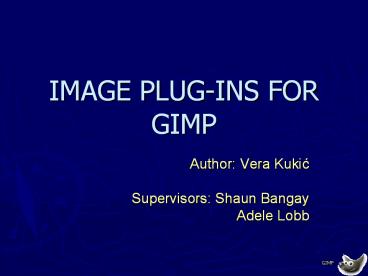IMAGE PLUG-INS FOR GIMP - PowerPoint PPT Presentation
Title: IMAGE PLUG-INS FOR GIMP
1
IMAGE PLUG-INS FOR GIMP
- Author Vera Kukic
- Supervisors Shaun Bangay
- Adele Lobb
2
GIMP
- Overview
- Recap
- GIMP
- Image Plug-ins
- Research
- Algorithm
- Colour Transfer Algorithm
- Image Inpainting Algorithm
- Phases
- Questions
3
GIMP
- GIMP is the GNU Image Manipulation Package
- Open source
- Well documented
- A lot of reference material available
- Easy to use
4
Image Plug-ins
- Colour Transfer between Images
- Transferring colour from a source colour image to
a destination greyscale image - Image Inpainting
- Touching up old photos
- Removing unwanted objects/text from images
5
Research
- Research based on
- Transferring Color to Greyscale Images
- Image Inpainting
- Read the papers that were referenced by the
authors of the original papers - Mathematics visited the maths department on a
number of occasions - Developed strategy and algorithms
6
Colour Transfer Algorithm
- Choose the source colour image and the
destination greyscale image - Convert each image to the laß
- Select colour from source image using swatches
- Transfer the swatch colour to the selected region
of the greyscale image
7
Colour Transfer Algorithm
- Convert each image to the laß
- The laß space was developed to reduce the
correlation between the 3 coordinate axis of the
colour space - l chromatic luminance channel
- a yellow-blue channel
- ß red green channel
8
Colour Transfer Algorithm
- Convert each image to the laß
- First convert RGB image to XYZ tristimulus values
- Then convert XYZ to LMS space
- From LMS space convert to laß space
9
RGB to LMS
- // convert RGB to LMS.
- void rgbtolms (double r, double g, double b,
- double l, double m, double
s) - l 0.3811 r 0.5783 g 0.0402 b
- m 0.1967 r 0.7244 g 0.0782 b
- s 0.0241 r 0.1288 g 0.8444 b
10
RGB to laß
- // convert RGB to lab (human perceptual space).
- void rgbtolab (double r, double g, double b,
- double l, double alpha, double
beta) - double ll
- double mm
- double ss
- double L
- double M
- double S
- rgbtolms (r, g, b, ll, mm, ss)
- L log10 (ll BLACKOFFSET)
- M log10 (mm BLACKOFFSET)
- S log10 (ss BLACKOFFSET)
- l (L M S) / sqrt (3.0)
11
Colour Transfer Algorithm
- Swatches
- Allow more user interaction
- User can selectively transfer colours between
corresponding swatches - Advantage
- Prevent wrong parts of the image from corrupting
the swatch - Transfer colour even if two corresponding regions
vary greatly in colour and luminance
12
Colour Transfer Algorithm
- Transfer colour
- Each pixel in the greyscale image must be matched
to a pixel in the colour image - The comparison is made based on luminance value
and neighbourhood statistics - Luminance value l
- Neighbourhood stats are precomputed over the
image - Standard deviation of the luminance values of the
pixel neighbourhood
13
Colour Transfer Algorithm
- Transfer colour
- The aß values are transferred once the best
matching pixel is found - The original luminance is retained
14
Image Inpainting Algorithm
- Discrete Equation
- Rate of change of I(i,n)
- Estimate Smoothness of Function
- Use discrete implementation of Laplacian
- Compute Change of Value
- Define direction of N (the normal vector)
15
Image Inpainting Algorithm
- Diffusion Process
- Interleaved with the image inpainting process
- Repeated every few steps to ensure the correct
evolution of the direction field - Process is repeated until steady state reached
16
GUI
17
Phases
- Research
- Read understand the mathematics behind the
methods of implementation - Develop Algorithm
- GUI
- Learn GTK
- Design Interface
- Implement the algorithm
- Test
- Experiments
18
Questions?
- ?































